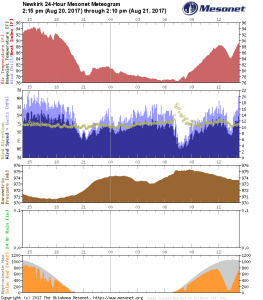As the eclipse passed us yesterday, scientists were carefully studying not only the outer atmosphere of the sun, or corona, which is normally hidden in the glare from the main ball of the sun, but also the impacts of the eclipse on Earth’s atmosphere. In Athens we noticed that the fair-weather cumulus clouds we often see during the day were going away as the temperature dropped and did not return until after the eclipse ended. The temperature in Athens dropped several degrees (it felt great!) and the light dimmed significantly, although it was more like twilight than true dark and happened very quickly (although long enough for the stadium lights to come on). Bob Henson of Weather Underground has a nice summary of some of the meteorological findings so far from locations around the country at https://www.wunderground.com/cat6/personal-eclipse-weather-impacts-atmosphere?__prclt=7nOSaHa2. I know there will be a lot more to come!
